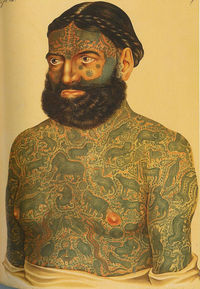Member bars and Prince Constantine: Difference between pages
(Page conversion via llm-mediawiki-rev -jwm) |
(Page conversion via llm-mediawiki-rev -jwm) |
||
| Line 1: | Line 1: | ||
[[File:Constantine.jpg|thumb|right|200px|Prince Constantine]] | |||
'''Prince Constantine''' or '''Captain Constentenus''' (also known as Alexandrinos Constentenus, Djordgi Konstantinus, George Constantine) rumored to have been born in 1836, was an Albanian Greek man who was covered in elaborate tattoos and worked as a "Tattooed Man". He was billed as and appeared as the [[Tattoo|tattooed]] man in [[Barnum]]'s Great Traveling Exposition in [[1873]]. He told a tale of capture and forcible tattooing, reminiscent of those who came before him (like [[Cabri]], [[Rutherford]], and [[O'Connel]]), however, his tattooing was far more elaborate and extensive: | |||
:''...consisted of 388 symmetrically arranged and closely interwoven images that covered his entire body, including his face, eyelids, ears, and penis. The designs, according to his publicity, consisted of crowned sphinxes, dragons, serpents, monkeys, elephants, leopards, tigers, lions, panthers, gazelles, cats, crocodiles, lizards, eagles, storks, swans, peacocks, owls, fishes, salamanders, men and women, fruit, leaves, and flowers. Most of them were quite small but exceptionally exact in their detail.''—from ''Freaks, Geeks, & Strange Girls'', Hardy Marks Publications p. 102-103 | |||
Experts of the time concluded his tattoos were done in the Burmese style and that Constantine had likely had the tattooing done while in Southeast Asia with the deliberate intention of becoming a tattooed exhibit. Later on in his career he is said to have admitted to having the work done by Spanish and Italian tattoo artists who had learned the art while serving as sailors. It is impossible to completely and accurately discern the facts of his life and the origins of his tattoos due to his stories constantly changing to suit his needs and changing audiences. Regardless, it is almost certain that Constantine was the first person to consciously decide to get tattooed as a professional career move. And, he may well have also been one of the most successful ever in the career he helped to create; his salary with Barnum was reported as $1,000 a week, still good today but incredible in the late 1800's. | |||
Legend also has it that, upon seeing Constantine, [[Charles Wagner]] was inspired and immediately set out to learn tattooing, eventually securing an apprenticeship with [[Samuel O'Reilly]] who patented the first electric [[Tattoo machine]]. He was also cited by [[Irene Woodward]], one of the first [[Tattooed ladies]], as her inspiration for going under the needle. | |||
[[File:Constentenus-785270.jpeg|thumb|right|180px]] | |||
== See Also == | |||
*[[Sideshow]] | |||
Latest revision as of 10:09, 17 September 2023
Prince Constantine or Captain Constentenus (also known as Alexandrinos Constentenus, Djordgi Konstantinus, George Constantine) rumored to have been born in 1836, was an Albanian Greek man who was covered in elaborate tattoos and worked as a "Tattooed Man". He was billed as and appeared as the tattooed man in Barnum's Great Traveling Exposition in 1873. He told a tale of capture and forcible tattooing, reminiscent of those who came before him (like Cabri, Rutherford, and O'Connel), however, his tattooing was far more elaborate and extensive:
- ...consisted of 388 symmetrically arranged and closely interwoven images that covered his entire body, including his face, eyelids, ears, and penis. The designs, according to his publicity, consisted of crowned sphinxes, dragons, serpents, monkeys, elephants, leopards, tigers, lions, panthers, gazelles, cats, crocodiles, lizards, eagles, storks, swans, peacocks, owls, fishes, salamanders, men and women, fruit, leaves, and flowers. Most of them were quite small but exceptionally exact in their detail.—from Freaks, Geeks, & Strange Girls, Hardy Marks Publications p. 102-103
Experts of the time concluded his tattoos were done in the Burmese style and that Constantine had likely had the tattooing done while in Southeast Asia with the deliberate intention of becoming a tattooed exhibit. Later on in his career he is said to have admitted to having the work done by Spanish and Italian tattoo artists who had learned the art while serving as sailors. It is impossible to completely and accurately discern the facts of his life and the origins of his tattoos due to his stories constantly changing to suit his needs and changing audiences. Regardless, it is almost certain that Constantine was the first person to consciously decide to get tattooed as a professional career move. And, he may well have also been one of the most successful ever in the career he helped to create; his salary with Barnum was reported as $1,000 a week, still good today but incredible in the late 1800's.
Legend also has it that, upon seeing Constantine, Charles Wagner was inspired and immediately set out to learn tattooing, eventually securing an apprenticeship with Samuel O'Reilly who patented the first electric Tattoo machine. He was also cited by Irene Woodward, one of the first Tattooed ladies, as her inspiration for going under the needle.
